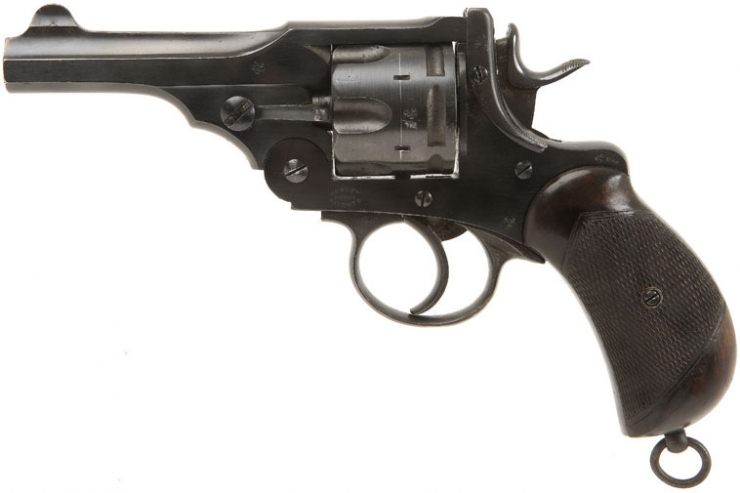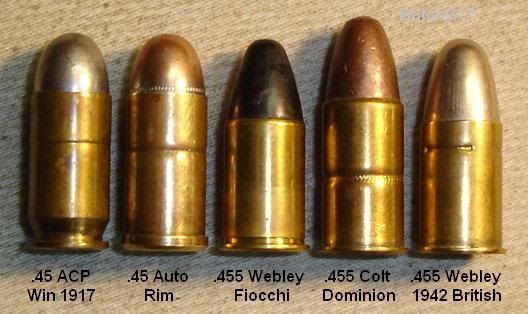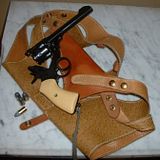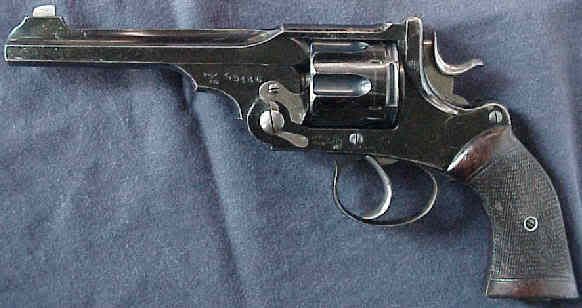Gentlemen,
The Webley service revolvers from 1887 onwards are possibly the finest example of revolvers, especially, service revolvers. I will argue that there are none better (well, perhaps the Fosbery, but they're a tad absurd and complex), and even modern semi-automatic pistols cannot match its abilities.
For this post, I will use the Webley & Scott Mk.VI revolver in .455 Mk.II as a reference, as it is the most common, and the summit of service revolvers (the .38 S&W Mk.IVs and Enfield No.2 Mk.Is aren't comparable).
First and foremost, consider this: a service revolver was not just a sidearm strapped to someone's hip as a weapon of 'last resort.' British officers, up until fairly modern times, were not issued rifles, sub machine guns, or what have you.
In a practice beginning with the Beaumont-Adams revolvers of the 1850s, British officers equipped themselves with privately purchased revolvers. Many of the revolvers made in the second half of the 19th century by the great, various British firms are completely solid designs and the number that survive to this day is a testament to their quality.
By 1887, Webley & Scott had already established itself as a great revolver manufacturer. The Boxer Revolver (i.e. Webley No.1) was a revolutionary revolver that fired the first cartridge primed by a Boxer primer, and at a whopping .577, it was very formidable. But it wasn't until 1887 that they began to move from civilian oriented self defense style pistols (e.g. the British Bulldog and R.I.C. Revolver style handguns) to firearms more suited for the British officer corps serving in the now expansive Victorian era Empire. The Webley Mk.I service revolver began replacing the somewhat poorly designed Enfield No.I and No.II revolvers. Here is an example of a Mk.I revolver:

All Webley revolvers following the Mk.I were essentially built in the same fashion. Top break, automatic ejection (and yes, it only ejects the spent cases), square, bulky frame. Not much changed from the Mk.I to the Mk.IV, apart from barrel lengths, grip and hammer shapes, and the types of steel.
The Mk.V was introduced in 1913 just in time for the First World War, the barrels were more or less standardized at 5" (some were made shorter, longer), but most importantly, the Mk.V could fire cordite charges. The .455 Mk.I black powder cartridge was cut down a good amount to form the .455 Mk.II.
I'll take a break from design history to go into detail about the cartridge itself.
The .455 Mk.I was designed for the Webley Mk.I, more or less. It was an evolution of the .476 Eley/Enfield, which was actually the exact same calibre as .455 Mk.I (and Mk.II). .476 Eley can be fired out guns that can fire .455 Mk.I(I) but not the other way around. The Mk.I featured a .455 calibre (just under, I believe, something like .454") round nosed, hollow based, solid lead, unjacketed bullet, with three lubrication grooves. Here's a good photo comparing .455 with .45 ACP and such:

Note that the .455 Colt is actually the same as .455 Mk.I (black powder), and the WWII era .455 is jacketed, I believe it's designated the Mk.IV (.455 Mk.I sort of broke the Hague Convention once it was put in place). From the very start, the .455 was wildly popular with the officer corps, and one can observe that the round was in use until it was finally decommissioned, many years after its declared obsolescence in 1923, in the late 1950s. A good 80 years of service with minimal changes.
A sort of odd source of praise for the .455 was from the exceptionally controversial Thompson-LeGarde Trials responsible for the adoption of the .45ACP round and the M1911 (later the 1911A1) in the US. Essentially, a bunch of men, including the future inventor of the Thompson SMG, now Colonel John Thompson, took a menagerie of pistols of all calibres to a ranch and started shooting steer in different ways in an attempt to gauge how well each round could produce the much needed 'stopping power.' Before I continue, all the tests were almost completely unscientific (think Deadliest Warrior on SPIKE), and the results are largely contested and seen as an attempt to just prove that the .45 calibre was the best. Apart from finding that the many calibres produced odd deaths in the steer, the primary recommendation that the board put forth was for a cartridge similar to the .455 Mk.III, which was the 'man stopper' configuration (a wad cutter). Take that with a grain of salt and as you will.
Interestingly enough, both the black powder and cordite cartridges were nearly identical. Both propelled a 265 grain bullet (same, exact specifications) at nearly the same velocity, approximately 650 fps (different ammo loadings vary, of course, e.g. Fiocchi is very hot at close to 850 fps). This is interesting. They could have easily retained the extra length of the black powder cartridge and used the same same volume of cordite to increase the velocity. However, even throughout the 20th century, this change was never made. Most wartime production ammunition is clocked at 650-700fps. The reason for this is my next point.
Increasing the velocity of the massive .455 265 grain projectile would indubitably increase recoil quite expressly (a .45 ACP pistol actually produces more recoil firing a 235 grain projectile at 850fps). The recoil on the Webley Mk.VI is quite mild for the size of projectile.
Now, I'm sure everyone has seen old war footage or pictures of officers (of any country) firing pistols. The standard stance for firing a pistol, even semi-automatic, was feet shoulder width apart, right foot facing forward (there were no left handed people ) with the left foot facing perpendicular to the target. Left hand is held at the waist, right arm is pointing straight outward with revolver in hand. The revolver is gripped somewhat loosely, by no mean a death grip.
) with the left foot facing perpendicular to the target. Left hand is held at the waist, right arm is pointing straight outward with revolver in hand. The revolver is gripped somewhat loosely, by no mean a death grip.
This is by far the best stance, even compared to modern Weaver and isosceles stances, to fire a revolver of this calibre, giving the user a great advantage in accuracy and rate of fire.
When discharged, the muzzle would flip a good 4" upwards. Since one's grip on the pistol is rather loose, it rocks backwards in the hand. One then positions the thumb onto the hammer, and using a downward motion to both return the pistol to a downward angle (the pistol is not held at a level, but at a downward angle) and easily re-cock the hammer using the leverage created by the weight of the gun. Here is an illustration from F.E. Morton's article on proper revolver technique from the February edition of Defense - the Services in 1941:

Effectively, it allows the operator to maintain the rate of fire associated with a double action revolver or even a semi-automatic pistol, while maintaining a very reasonable trigger pull (8lbs in single action versus the 14lbs in double action), and producing a very manageable recoil (inherently, revolvers produce less recoil than semi-autos as there isn't a large piece of steel slamming back and forth, same goes for bolt action rifles and semi-automatics of the same calibre). Although I don't agree completely with Ex-CPO Morton on this issue, it's still worth considering, a revolver doesn't need magazines to fire six rounds. He mentions the probability of jams (or jambs as he writes) in semi-autos, but I suspect this is due to the quality of earlier semi-autos. While it's getting rarer and rarer for modern semi-autos to jam, there is always the possibility that something in the system will break down. A revolver is virtually impossible to jam (usually a result of user error or poor ammunition), and as long as you have ammunition, you can keep loading it. With a semi-automatic, you're limited to how many magazines you can carry on your person (this might have been a problem for soldiers, not so much for most civilians now a days).
Also, a revolver is inherently slower to reload. This was poorly overcome with the implementation of the 'Prideaux Device.' A speed-loader by any means, but a damnably good one at that. Unlike most speed-loaders which require a twist or turn of some sort, the PD was a single motion (rounds lined up to holes, and the top was pushed down). Had they not been so exceedingly expensive to produce (very complex piece of metal, very rare now, too), they would have overcome this fault, and reload time would very well be faster than some semi-automatics.
Continuing on with the development of the Webley revolver, the late 19th century saw many great designs, the Webley WG and the Webley-Wilkinson. The invention of the world's first, and for a good span of time, only semi-automatic revolver - the Webley Fosbery. The revolver was cocked like a semi-automatic - the top part of the frame reciprocated on a rail just above the grip. After each shot recoil would drive the top section backwards, force the cylinder into the next shot by driving a stud through channels carved in the cylinder, and returning the hammer to the cocked position. It was remarkably accurate and quick. They had problems in the trenches on the Western Front during the First World War, as mud would enter the aforementioned channels and make it a clunk of useless steel as opposed to the most magnificent revolver ever produced.
In 1916, after shortages of Mk.V revolvers was encountered, the Webley Mk.VI was introduced. Basically, it is the summit of service revolver evolution. The grips were changed to a more manageable squared off look (as opposed to the round, bird's head ones in the earlier marks), a removable blade site was added, the rear site was a combination of a V and a U (one for 50 yards, one for 20 yards, respectively), and the barrel was lengthened to 6". Even though it was only manufactured from 1916 to 1921, and later at Enfield by the Royal Small Arms Factory from 1921-1926, they were in service from the First World War into the Korean Conflict. Again, there are vast amounts of these pistols to be had in the modern market, most in very reasonable condition.
Here's a picture I took of mine with my Fairbairn-Sykes dagger:

Now if I could just find a way to conceal such a behemoth pistol, it would make a fantastic CC weapon. Or I could get out of Texas and move to a state with open carry... nah.
The Webley service revolvers from 1887 onwards are possibly the finest example of revolvers, especially, service revolvers. I will argue that there are none better (well, perhaps the Fosbery, but they're a tad absurd and complex), and even modern semi-automatic pistols cannot match its abilities.
For this post, I will use the Webley & Scott Mk.VI revolver in .455 Mk.II as a reference, as it is the most common, and the summit of service revolvers (the .38 S&W Mk.IVs and Enfield No.2 Mk.Is aren't comparable).
First and foremost, consider this: a service revolver was not just a sidearm strapped to someone's hip as a weapon of 'last resort.' British officers, up until fairly modern times, were not issued rifles, sub machine guns, or what have you.
In a practice beginning with the Beaumont-Adams revolvers of the 1850s, British officers equipped themselves with privately purchased revolvers. Many of the revolvers made in the second half of the 19th century by the great, various British firms are completely solid designs and the number that survive to this day is a testament to their quality.
By 1887, Webley & Scott had already established itself as a great revolver manufacturer. The Boxer Revolver (i.e. Webley No.1) was a revolutionary revolver that fired the first cartridge primed by a Boxer primer, and at a whopping .577, it was very formidable. But it wasn't until 1887 that they began to move from civilian oriented self defense style pistols (e.g. the British Bulldog and R.I.C. Revolver style handguns) to firearms more suited for the British officer corps serving in the now expansive Victorian era Empire. The Webley Mk.I service revolver began replacing the somewhat poorly designed Enfield No.I and No.II revolvers. Here is an example of a Mk.I revolver:

All Webley revolvers following the Mk.I were essentially built in the same fashion. Top break, automatic ejection (and yes, it only ejects the spent cases), square, bulky frame. Not much changed from the Mk.I to the Mk.IV, apart from barrel lengths, grip and hammer shapes, and the types of steel.
The Mk.V was introduced in 1913 just in time for the First World War, the barrels were more or less standardized at 5" (some were made shorter, longer), but most importantly, the Mk.V could fire cordite charges. The .455 Mk.I black powder cartridge was cut down a good amount to form the .455 Mk.II.
I'll take a break from design history to go into detail about the cartridge itself.
The .455 Mk.I was designed for the Webley Mk.I, more or less. It was an evolution of the .476 Eley/Enfield, which was actually the exact same calibre as .455 Mk.I (and Mk.II). .476 Eley can be fired out guns that can fire .455 Mk.I(I) but not the other way around. The Mk.I featured a .455 calibre (just under, I believe, something like .454") round nosed, hollow based, solid lead, unjacketed bullet, with three lubrication grooves. Here's a good photo comparing .455 with .45 ACP and such:

Note that the .455 Colt is actually the same as .455 Mk.I (black powder), and the WWII era .455 is jacketed, I believe it's designated the Mk.IV (.455 Mk.I sort of broke the Hague Convention once it was put in place). From the very start, the .455 was wildly popular with the officer corps, and one can observe that the round was in use until it was finally decommissioned, many years after its declared obsolescence in 1923, in the late 1950s. A good 80 years of service with minimal changes.
A sort of odd source of praise for the .455 was from the exceptionally controversial Thompson-LeGarde Trials responsible for the adoption of the .45ACP round and the M1911 (later the 1911A1) in the US. Essentially, a bunch of men, including the future inventor of the Thompson SMG, now Colonel John Thompson, took a menagerie of pistols of all calibres to a ranch and started shooting steer in different ways in an attempt to gauge how well each round could produce the much needed 'stopping power.' Before I continue, all the tests were almost completely unscientific (think Deadliest Warrior on SPIKE), and the results are largely contested and seen as an attempt to just prove that the .45 calibre was the best. Apart from finding that the many calibres produced odd deaths in the steer, the primary recommendation that the board put forth was for a cartridge similar to the .455 Mk.III, which was the 'man stopper' configuration (a wad cutter). Take that with a grain of salt and as you will.
Interestingly enough, both the black powder and cordite cartridges were nearly identical. Both propelled a 265 grain bullet (same, exact specifications) at nearly the same velocity, approximately 650 fps (different ammo loadings vary, of course, e.g. Fiocchi is very hot at close to 850 fps). This is interesting. They could have easily retained the extra length of the black powder cartridge and used the same same volume of cordite to increase the velocity. However, even throughout the 20th century, this change was never made. Most wartime production ammunition is clocked at 650-700fps. The reason for this is my next point.
Increasing the velocity of the massive .455 265 grain projectile would indubitably increase recoil quite expressly (a .45 ACP pistol actually produces more recoil firing a 235 grain projectile at 850fps). The recoil on the Webley Mk.VI is quite mild for the size of projectile.
Now, I'm sure everyone has seen old war footage or pictures of officers (of any country) firing pistols. The standard stance for firing a pistol, even semi-automatic, was feet shoulder width apart, right foot facing forward (there were no left handed people
This is by far the best stance, even compared to modern Weaver and isosceles stances, to fire a revolver of this calibre, giving the user a great advantage in accuracy and rate of fire.
When discharged, the muzzle would flip a good 4" upwards. Since one's grip on the pistol is rather loose, it rocks backwards in the hand. One then positions the thumb onto the hammer, and using a downward motion to both return the pistol to a downward angle (the pistol is not held at a level, but at a downward angle) and easily re-cock the hammer using the leverage created by the weight of the gun. Here is an illustration from F.E. Morton's article on proper revolver technique from the February edition of Defense - the Services in 1941:

Effectively, it allows the operator to maintain the rate of fire associated with a double action revolver or even a semi-automatic pistol, while maintaining a very reasonable trigger pull (8lbs in single action versus the 14lbs in double action), and producing a very manageable recoil (inherently, revolvers produce less recoil than semi-autos as there isn't a large piece of steel slamming back and forth, same goes for bolt action rifles and semi-automatics of the same calibre). Although I don't agree completely with Ex-CPO Morton on this issue, it's still worth considering, a revolver doesn't need magazines to fire six rounds. He mentions the probability of jams (or jambs as he writes) in semi-autos, but I suspect this is due to the quality of earlier semi-autos. While it's getting rarer and rarer for modern semi-autos to jam, there is always the possibility that something in the system will break down. A revolver is virtually impossible to jam (usually a result of user error or poor ammunition), and as long as you have ammunition, you can keep loading it. With a semi-automatic, you're limited to how many magazines you can carry on your person (this might have been a problem for soldiers, not so much for most civilians now a days).
Also, a revolver is inherently slower to reload. This was poorly overcome with the implementation of the 'Prideaux Device.' A speed-loader by any means, but a damnably good one at that. Unlike most speed-loaders which require a twist or turn of some sort, the PD was a single motion (rounds lined up to holes, and the top was pushed down). Had they not been so exceedingly expensive to produce (very complex piece of metal, very rare now, too), they would have overcome this fault, and reload time would very well be faster than some semi-automatics.
Continuing on with the development of the Webley revolver, the late 19th century saw many great designs, the Webley WG and the Webley-Wilkinson. The invention of the world's first, and for a good span of time, only semi-automatic revolver - the Webley Fosbery. The revolver was cocked like a semi-automatic - the top part of the frame reciprocated on a rail just above the grip. After each shot recoil would drive the top section backwards, force the cylinder into the next shot by driving a stud through channels carved in the cylinder, and returning the hammer to the cocked position. It was remarkably accurate and quick. They had problems in the trenches on the Western Front during the First World War, as mud would enter the aforementioned channels and make it a clunk of useless steel as opposed to the most magnificent revolver ever produced.
In 1916, after shortages of Mk.V revolvers was encountered, the Webley Mk.VI was introduced. Basically, it is the summit of service revolver evolution. The grips were changed to a more manageable squared off look (as opposed to the round, bird's head ones in the earlier marks), a removable blade site was added, the rear site was a combination of a V and a U (one for 50 yards, one for 20 yards, respectively), and the barrel was lengthened to 6". Even though it was only manufactured from 1916 to 1921, and later at Enfield by the Royal Small Arms Factory from 1921-1926, they were in service from the First World War into the Korean Conflict. Again, there are vast amounts of these pistols to be had in the modern market, most in very reasonable condition.
Here's a picture I took of mine with my Fairbairn-Sykes dagger:

Now if I could just find a way to conceal such a behemoth pistol, it would make a fantastic CC weapon. Or I could get out of Texas and move to a state with open carry... nah.




